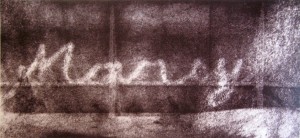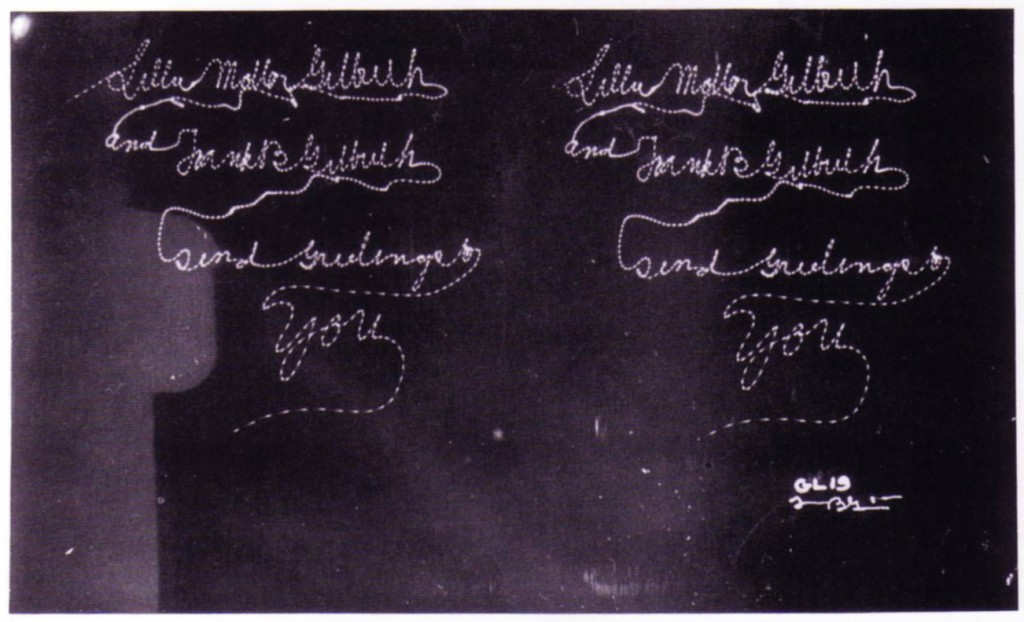Like the discourse network of 1900, let us begin in nonsense (so as to end in reason). Consider an image made by Étienne-Jules Marey, not one of the chronophotographic images of decomposed movement that he is known for, but one made as he was playing around in his studio. "I picked up a black stick capped with a white ball at its tip,” he wrote. “By walking and moving it around in front of the black screen I was able to write out my name letter by letter."

The image is weak and grainy. As author of the word, Marey appears simply as a passing ghost, washing out the right side of the photograph with a broad smudge of white. This is not a photograph in any strict sense, at least not technically. As a photographic record of kinetic change through time it might go by a better name: cinema. Digitality has dominated cinema throughout its history -- discrete photographs arranged in corpuscular series -- that it's difficult to see how radical this image really is. Let's call it by its true name, for here is a genuinely analog cinema.
Compare Marey's cinema-of-names to a corresponding image made by Lillian and Frank Gilbreth circa 1914.

The Marey and Gilbreth images are similar in a superficial sense. Both inscribe the authors' names using light against a sensitive skin. One reflects light off a white ball, the other shines illumination from a light pen. Both present a relatively inconsequential and semantically thin series of letters and words that exist merely to demonstrate the functionality of a specific media technique. (I say this without doubting for a moment that the Gilbreths sincerely wish to send their best greetings!)
Yet differences exist as well: the Gilbreths were known to use a pen of strobing light, visible here as white pixels; and yet in contrast to their pixel font, Marey's is a vector font of continuous curves. One is a cursive cursive, while the other is a noncursive cursive. So if the Marey cinema-of-names is an analogue cinema -- that strange beast as rare as a giant squid -- the Gilbreth cinema-of-names is a “normal” (which is to say digital) cinema, marking time in segments, and strobe-stepping from one moment to another.
The image on the Gilbreth card is in duplicate. Why duplicate? To twenty-first-century eyes such things are a mystery, yet to anyone living around the turn of the twentieth century it would have instantly meant one thing very specific, a stereoscopic picture.
The unusual characteristics of this particular media artifact can thus be summarized: (1) it is a “digital” or “corpuscular” cinematic photograph; (2) it is written by hand in light using a strobing pixel pen; (3) and, to top it all off, it is rendered in three dimensions using stereoscopy.
The desire to write one's name is common in the genre of demo media. It is the demonstration that is important, not the content expressed therein. So it goes with Peter Mitterhofer’s extremely unusual typewriter of 1864, which featured a typeface built up from pixels. And what did he use it for but to write out his name.
 Or Frederic Williams and Tom Kilburn who in Manchester in 1947 write the letters “C.R.T. STORE” to to the screen of a custom-built oscilloscope, thereby inaugurating the era of the raster grid computing display with the nonsensical utterance of the obvious: I am a device, and my name is a “cathode-ray tube store.”
Or Frederic Williams and Tom Kilburn who in Manchester in 1947 write the letters “C.R.T. STORE” to to the screen of a custom-built oscilloscope, thereby inaugurating the era of the raster grid computing display with the nonsensical utterance of the obvious: I am a device, and my name is a “cathode-ray tube store.”
Or John von Neumann and his engineers at the Institute for Advanced Study, who would copy the Williams-Kilburn demo a year later with a demo of their own, writing “ECPIAS” to the screen of a Williams tube. ECPIAS: the name of the “Electronic Computer Project at the Institute for Advanced Study.”
Or recall how when IBM learned to write using xenon atoms as pixels, they spelled out three micro letters and nothing else, I-B-M. All elegant demonstrations of function, to be sure, but all equally offensive to sensible expression.
Marey wrote his name in light, and we know that his protege, Georges Demenÿ, was also a master of the senseless cinema-of-names.

Demenÿ wrote his name using chronophotographic techniques on a number of occasions, the letters spelling forth like the staccato breaks between frames: D-e-m-e-n-ÿ. In "The Photography of Speech," perhaps his most well known project, Demenÿ moves beyond names to phrases marginally more rich in semantic content but still just as banal, not “Demenÿ” but “long live France” and “I love you.”
Or recall the delightful scene from Singin' in the Rain, when the big film studio executive calls everyone around to watch a short film demonstrating the introduction of sound into silent pictures.
The man inside the film addresses the audience directly:
Hello.
This is a demonstration of a talking picture. Notice, it is a picture of me, and I am talking. Note how my lips, and the sound issuing from them, are synchronized together in perfect unison. [...]
My voice has been recorded on a record. A talking picture.
Thank you.
Goodbye.
Something is constraining the medium. It can do little more than narrate nonsensically the conditions of its own material functioning. To speak its name and its name alone. The man rises to demonstrate the technique, hello, this is a demonstration of a talking picture. The man addresses us with his eyes, it is a picture of me. The man speaks, I am talking. The talking picture says: I am a talking picture.
In response, despite such explicit explanations as to what is going on, the audience of party-goers all cry in unison: What nonsense! Whoever is talking behind that screen, come out!
In the parlance of computer coders, all of these examples are called “Hello World” tests. As the first application one customarily writes when learning a new computer language, the “Hello World” test launches, writes the words “Hello World” to the screen, then quits. Verification that the machine works, nothing more. The words themselves mean very little. It is the fact of their functioning that counts.
*
I said I would begin in nonsense, and here we have it. The Marey and Gilbreth images mentioned at the outset, as well as these other examples, display a characteristic that one might call the “phatic” principle or, using an amusing moniker, the principle of “functional nonsense.” These examples are also all characteristic of the general category of the media of technical demonstration -- demo media. They are labeled “functional” because the formal details in question perform a vitally important role in the necessary functioning of the artifact as a whole, and are therefore functionally necessary. But they are also “nonsense” because the formal details in question have very little weight at the semantic level, and are thus in spite of themselves compositionally irrelevant. McLuhan had the right idea, but he missed an important detail, for the content of every new demonstration medium isn't always another medium. Quite often it's nothing.
The phatic principle indicates that there are always aspects to communication that carry no information, that convey no meaning, that execute no speech act, that launch no interrogative. Instead these communicative utterances serve in a purely functional capacity. They establish and maintain connections. They inaugurate new modes of mediation. They reiterate the obviousness of the technical condition. They are the nothing filler for an otherwise blank channel.
Must all demo media reduce content to silly nothingness, to the redundancy of naming, to descriptions of the obvious? Can the first expressive artifact also be a sensible one? Is the power of the medium so overwhelming that it eclipses expression, or is the issue more fundamental? Perhaps the logic of functional nonsense indicates that the theory of remediation handed down from McLuhan is not infallible, that one must expand one's notion of mediation to include these examples of non-media, media artifacts that achieve so much in the very gesture of their own demonstration, that they scare away any last ability to communicate beyond the most basic grunts. The raw output of the apparatus is what matters; the medium itself is what is important.
In the end, maybe this is the wrong question. Instead one might ask: Why does function precede meaning? Why does act precede sense?
Function is ancient; meaning is medieval; but illumination is modern. (And today, to the chagrin of many, it appears that function is post-modern again.) One should take this historically, not in terms of abstract truth or raw causality, but as the unfolding of particular conditions of existence. And here things start to get interesting, because we can begin to recombine the very conditions of historical fact. What of a postmodernity not rooted in function? What of an illuminated gothic? What of the reason of the ancients?